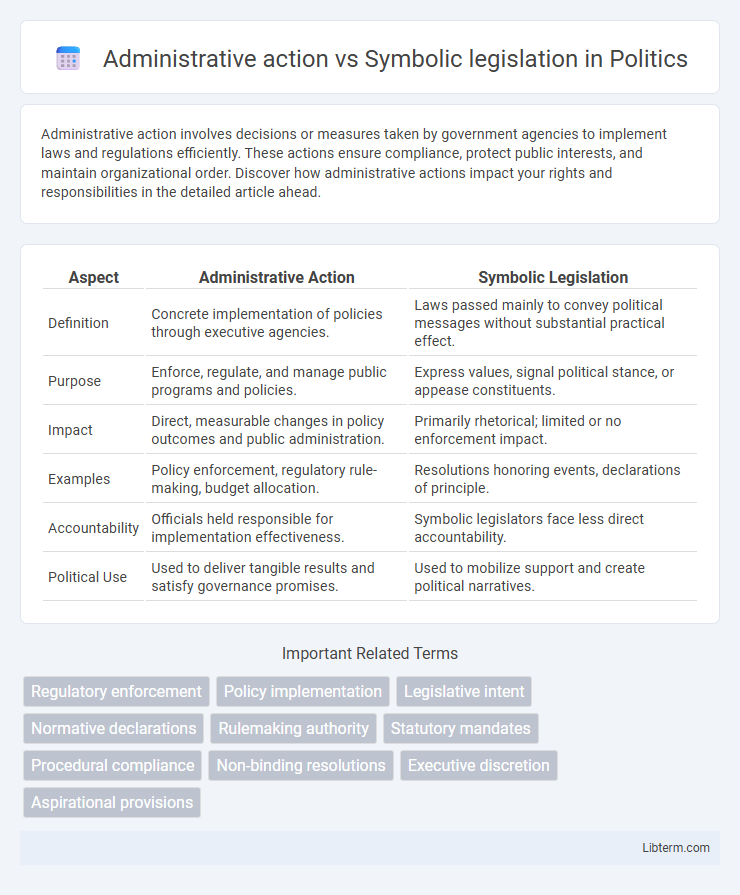Administrative action involves decisions or measures taken by government agencies to implement laws and regulations efficiently. These actions ensure compliance, protect public interests, and maintain organizational order. Discover how administrative actions impact your rights and responsibilities in the detailed article ahead.
Table of Comparison
| Aspect | Administrative Action | Symbolic Legislation |
|---|---|---|
| Definition | Concrete implementation of policies through executive agencies. | Laws passed mainly to convey political messages without substantial practical effect. |
| Purpose | Enforce, regulate, and manage public programs and policies. | Express values, signal political stance, or appease constituents. |
| Impact | Direct, measurable changes in policy outcomes and public administration. | Primarily rhetorical; limited or no enforcement impact. |
| Examples | Policy enforcement, regulatory rule-making, budget allocation. | Resolutions honoring events, declarations of principle. |
| Accountability | Officials held responsible for implementation effectiveness. | Symbolic legislators face less direct accountability. |
| Political Use | Used to deliver tangible results and satisfy governance promises. | Used to mobilize support and create political narratives. |
Introduction: Defining Administrative Action and Symbolic Legislation
Administrative action refers to decisions or measures taken by government agencies to implement laws and policies, focusing on practical enforcement and regulation. Symbolic legislation involves laws passed primarily to express values or political messages without intending immediate, substantive impact on behavior or policy. Understanding this distinction is crucial for evaluating the effectiveness and purpose of different governmental actions within legal and political frameworks.
Historical Context of Administrative Action and Symbolic Laws
Administrative action emerged prominently during the Progressive Era as governments sought efficient regulation amid rapid industrialization and urbanization, reflecting a practical approach to law enforcement and public policy. Symbolic legislation, often enacted without intent of strict enforcement, surfaced as a political tool to express societal values or respond to public opinion, gaining prominence during periods of social change such as the Civil Rights Movement. The historical context reveals administrative actions prioritized bureaucratic control and accountability, while symbolic laws served as legislative statements embodying ideological or moral positions rather than immediate regulatory impact.
Legal Framework: Authority Behind Administrative Actions
Administrative action derives its authority from statutory laws granting governmental agencies the power to implement and enforce regulations within specific legal frameworks. Symbolic legislation, often embodying ceremonial or declarative enactments, lacks substantive enforcement mechanisms and primarily serves expressive or political functions. The legal framework underpinning administrative action emphasizes accountability, procedural compliance, and the delegation of powers, distinguishing it from the largely declarative nature of symbolic legislation.
Purpose and Intent: Goals of Symbolic Legislation
Symbolic legislation aims primarily to express societal values or political positions without creating significant legal consequences, serving as a tool to communicate public commitment or moral stance. Its purpose is to influence public opinion, signal policy priorities, or placate interest groups rather than effectuate direct administrative change. Unlike administrative action, which targets practical enforcement and specific regulatory outcomes, symbolic laws prioritize expressive functions and reinforce cultural norms.
Mechanisms: How Administrative Actions Are Implemented
Administrative actions are implemented through regulatory agencies that develop, enforce, and monitor rules based on delegated legislative authority, often involving rulemaking, adjudication, and enforcement mechanisms. These actions rely on bureaucratic discretion, procedural formalities, and stakeholder consultations to ensure effective policy execution. In contrast, symbolic legislation primarily communicates political values or intentions without detailed enforcement mechanisms or immediate practical application.
Impact Assessment: Real-World Effects of Administrative Measures
Administrative action directly implements policies through regulations, permits, and enforcement, leading to immediate and measurable impacts on public behavior and organizational operations. Symbolic legislation often serves to signal political intentions or values without direct enforcement, resulting in limited or indirect real-world effects. Impact assessment of administrative measures reveals tangible outcomes such as compliance rates, economic shifts, and environmental improvements, whereas symbolic laws primarily influence public perception and political discourse.
Public Perception: Symbolic Legislation and Societal Influence
Symbolic legislation often shapes public perception by embodying societal values and signaling government commitment without immediate practical effects, reinforcing collective identity and cultural norms. This type of legislation influences social attitudes and public discourse more than administrative action, which primarily focuses on implementing concrete policies and regulations. Public acceptance and support frequently hinge on the symbolic power of laws that reflect shared ideals, even when tangible outcomes are limited.
Limitations and Criticisms of Administrative Actions
Administrative actions face limitations due to their potential lack of transparency and accountability, often leading to arbitrary or inconsistent enforcement of policies. Critics argue that administrative decisions can bypass democratic processes, concentrating power in unelected officials and undermining checks and balances. Symbolic legislation, although largely declarative, avoids these administrative pitfalls by explicitly stating policy intents without immediate legal enforcement, highlighting administrative actions' challenges in balancing effectiveness and legitimacy.
The Role of Symbolic Legislation in Policy Making
Symbolic legislation often serves to express societal values and signal government priorities without enacting substantive policy changes, contrasting with administrative action that implements concrete regulatory measures. Its role in policy making includes shaping public opinion, setting legislative agendas, and influencing future detailed reforms by creating a normative framework. Lawmakers use symbolic legislation strategically to address public demands and moral concerns, even when immediate administrative enforcement is limited.
Comparative Analysis: Administrative Action vs Symbolic Legislation
Administrative action involves concrete implementation of policies through enforcement agencies, ensuring compliance and delivering tangible outcomes, whereas symbolic legislation primarily serves as a formal declaration of intent without immediate enforceability or practical effect. Administrative actions are characterized by specific regulatory measures, resource allocation, and accountability mechanisms, while symbolic legislation often aims to signal political commitment, influence public opinion, or lay groundwork for future laws. Comparative analysis highlights that administrative action drives direct behavioral change and policy execution, whereas symbolic legislation functions largely as a tool for political messaging and agenda-setting.
Administrative action Infographic

 libterm.com
libterm.com